1951 commenced with an earnest attempt by the
US Air Force to simply explain "flying saucers" away as misidentified
high-flying jets or giant silvery cosmic ray research balloons.
With the cooperation of the US Air Force, and head of "Project Saucer,"
Colonel Harold E. Watson, columnist Bob Considine consolidated the
official disdain for the phenomenon into an article for Cosmopolitan
Magazine entitled "The Disgraceful Flying Saucer Hoax!"

Flying Saucers Really Balloons For Navy Cosmic Ray Studies
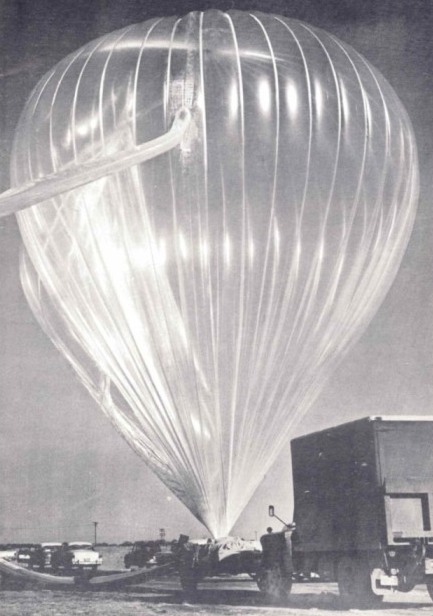
By the Associated Press
A Navy official confirmed today that "flying saucers" really existed but actually were huge balloons used in high-altltude cosmic ray studies.
Dr. Urner Liddell (sic), chief of the nuclear physics branch of the Office of Naval Research, made this disclosure in an article in the current Look magazine.
Dr. Liddel, in Washington, discussed the Look story further when newsmen queried him.
The Navy balloons. Dr. Liddel declared, were 100 feet in diameter and sometimes rose to a height of 19 miles. He added that winds might sweep them along at 200 miles an hour.
At dusk, the slanting rays of the sun lighted up the balloons' bottoms, giving them the saucer-like appearances, Dr. Liddel said.
He added that many of the disks were sighted as the sun set.
Dr. Liddell said the existence of the big balloons was kept secret because the project was connected wtih atomic developments.
Dr. Liddel, who was in charge of the balloon tests, said they carried instruments to record the results of collisions between cosmic rays and atoms In the earth's atmosphere.
He added that secrecy was "no longer" necessary.
The physicist said 2,000 reports of "flying saucers" were checked, and those considered "whimsical" were eliminated. Of the "reliable" reports, he said "there is not a single . . . observation which is not attributable to the cosmic balloons."
These balloons, called "Skyhooks" by the Navy, were first used in 1947, about the time the disks were flrst sighted. Dr. Liddel said reports of "flying saucers" increased in proportion to the number of balloons sent aloft.
Dr. Liddel said he was conivinced that a "saucer" photographed at 77,000 feet altitude over Minnesota was a "Skyhook."
"STRANGE OBJECT" IN SKY
Fliers Watch Dime-Like Thing
Hover Near Balloon
Two Wright-Patterson Air Force base officers last night reported they recently "saw a strange object" in the sky over Alamagordo, N. M.
Capt. J. E. Cocker of the all-weather flying division and Capt. E. W. Spradley of the aerial photographic laboratory said they spotted the object as they tracked a large weather balloon. The balloon was similar to the type used in Navy weather observations and which the Navy said explained "flying saucer" reports.
"We were following the balloon when I noticed a strange object in the sky," said Captain Spradley. "It was flat and looked like a dime. It was a milky color. It wasn't doing anything, just hovering near the balloon."
The fliers estimated the object and balloon were "somewhere around 50,000 or 60,000 feet." They said that just before it disappeared there were "three brilliant flashes, like photo flashes."
EDITORIAL
Saucers, Secrecy & Security
We congratulate Look Magazine for smoking out the 3½ year flying saucer mystery. We are sorry Aviation Week didn't solve it. Our alibi is that apparently very few knew the story outside of the Office of Naval Research—not even the Air Force, which sent or permitted its pilots to go on wild saucer chases. As it happened, though the project was not an aviation matter, Aviation Week came very close to the story in 1949.
Look Magazine has performed a public service. But its revelation is a tragic commentary on the low state of the Administration's sense of public duty, and an increasing trend toward unnecessary secrecy. For some three years government spokesmen, from President Truman and the former Secretary of the Air Force on down, told the people impatiently, as though they were children, that what they were seeing were mirages, misinterpretations of various conventional objects or nothing at all.
Yet now it comes out that even while the government was telling the people these things the ONR was busily surveying 2000 reports of “flying disks” and culling out a solid base of reports from plane pilots, scientific observers and reliable laymen. “After a thorough investigation we find there is not a single reliable report of an observation which is not attributable to the cosmic balloons,” said Dr. Urner Liddel, the project director.
We hope the Office of Naval Research can pull itself out of this scandal with a sensible reason for keeping this explanation secret for so long. It will have to be a very good reason to satisfy many of us. Otherwise we must charge off the supercolossal flying saucer hoax of the twentieth century as one more example of the chronic Washington tendency to classify everything as secret. Readers of this magazine have often read the opinion here that secrecy is overdone in the national capital; we have seen no better example than this.
The hoax the ONR has perpetrated brought on something akin to public hysteria in some areas, cost the Air Force, National Guard and other public services needless wasted monies in investigations and flights and, most tragic of all, cost the life of an Air Force pilot, Capt. Thomas F. Mantell, whose plane crashed while he was pursuing a “saucer” in 1948. Apparently then, months after the ONR balloon ascensions began, neither ONR nor high Navy officials had tipped off the Air Force, else we can presume the USAF would not order or permit its pilots to try to chase already identified objects that were known to rise to 19-mile-altitudes.
Even if the objectives were considered secret by the ONR, there could have been no apparent security breach in issuing a brief announcement as soon as newspaper reports about saucers began popping up. The announcement could have been restricted to a few words tying the eyewitness reports to new and larger balloons that were making upper air cosmic ray observations and the like. The public would have been satisfied immediately. Because it has known ever since Dr. Robert A. Millikan began taking them 30 years ago that observations of cosmic rays have been going on with balloons. And it also knows that weather balloons are in the air coast to coast, around the clock.
Look Magazine's story quotes Dr. Liddel as saying; “When this project first began, it was kept secret. Now, there is no longer any need for secrecy on a scientific basis. And certainly there is no longer any need to keep the public in the dark about what flying saucers are.“
The citizens who have been reading about these things for several years might ask why there was ever any need for secrecy as far as letting them in on the simple fact that larger balloons were being used than formerly to obtain secret information upstairs. What possible military secrecy is revealed by telling the people they are seeing balloons. What secrets does a balloon's configuration betray? Why permit a silly thing like this to develop to the point where human life is lost and the public begins reading about little creatures riding on flying saucers through inter-planetary space and crashing on earth?
The citizens might also ask—if the project was so secret until last week—why the ONR permitted one of its employes to write an official paper for delivery at a public scientific meeting two years ago.
Aviation Week itself in its issue of Feb. 7, 1949, carried a brief digest of a paper delivered in January, 1949, at the Institute of Aeronautical Sciences meeting in New York. The full text of the paper, by E. G. Droessler, a meteorologist of the Geophysics Branch of ONR, was never made available to us. The digest came to us from the Institute. Our headline said “The Navy Has a Skyhook.” The digest, as we printed it in early 1949, said:
“Comparatively successful plastic balloon has been developed and is being utilized in broad program of upper atmosphere research. In 52 flights, heavy loads have been carried to altitudes exceeding 30 km. (Note—This is 98,400 feet.) Scientific instruments are carried aloft to collect new information on cosmic rays, biological phenomena, meteorological parameters, etc.”
So the public has a right to know the answers to some questions.
If a public address could be delivered in early 1949 describing this hush-hush project even to the extent just quoted how could national security have been breached with the added simple statement that these new balloons could well be responsible for the frequent public reports of “flying saucers”?
Why was the flying saucer mystery permitted to grow out of all reasonable bounds after the first public response to seeing these new balloons? Why was it permitted to build up for three years to the extent of a world wide mystery and even loss of life? Even if ONR had its own reasons for wishing to maintain secrecy, why did not some high Navy official overrule his underlings and break the silence? And if the Navy still wished to keep its own counsel, why was it not overruled by someone even higher in our National Administration who had a serise of public duty and some perspective on this subject of secrecy and national security.
It may be a fair question to ask the ONR whether it deliberately maintained its secrecy not because of national security but in order to encourage the press to continue reporting flying saucers for it, so ONR could obtain its 2000 observations. Now that it has them, perhaps this is why Dr. Liddel says, “There is no longer any need for secrecy.”
If this is the explanation for the iron curtain around Project “flying saucers,” we are more than ever certain that this country needs a free press as it never needed it before.
— Robert H. Wood
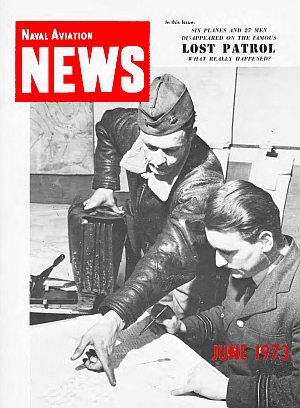
At the time of the event, Lt. B. was 30 years old, experienced in both North and South Atlantic flight, with qualifications in 38 types of aircraft.
The weather was excellent. The moon had set but visibility was good. Lt. B. and the plane commander, LCdr. K., who was in the copilot's seat, could make out the horizon clearly.
Asleep in the aircraft were two extra crews, one a relief for B.’s men, the other on board as passengers. The R5D was at 10,000 feet on a south-westerly course for Newfoundland, ground speed 200 knots. Three an a half hours out of Iceland, midpoint in the flight, they passed over a weather ship on station off the coast of Greenland. The ship reported normal conditions.
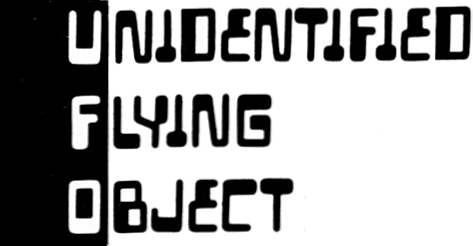
The aircraft was on autopilot. LCdr. K. and myself were on constant watch for other aircraft. I observed a yellow glow in the distance about 30 to 35 miles away at about the one o’clock position and below the horizon. My impression was that there was a small city ahead, because it was the same glow you get from a group of lights on the surface before you get close enough to pick them out individually.
“Knowing that our course took us past the tip of Greenland, my first thought was that we hadn’t yet reached it, that we were behind schedule and had drifted north, but remembering that we had passed over the weather ship, I realized this was not the case. I called K.’s attention to the glow and asked him what he thought it was. He said that it looked like we were approaching land. I asked our navigator to check our position. He did and replied that we were on flight plan and on course.
“The lights were farther away than we thought because it took us eight to ten minutes to get close enough to where the lights had a pattern (our ground speed was over three miles per minute), about 15 or 18 miles away. At that time, due to the circular pattern of lights, I got the impression that possibly two ships were tied up together and that lights were strung between them for either transferring cargo from one to the other or that one was in some kind of trouble.
“I asked the navigator to check his ship plot. He replied that there were no ships plotted in this area and that we were not close to the shipping lanes anyway. The radioman also went on the air to the weather ship, which verified that there were no ships in the area.
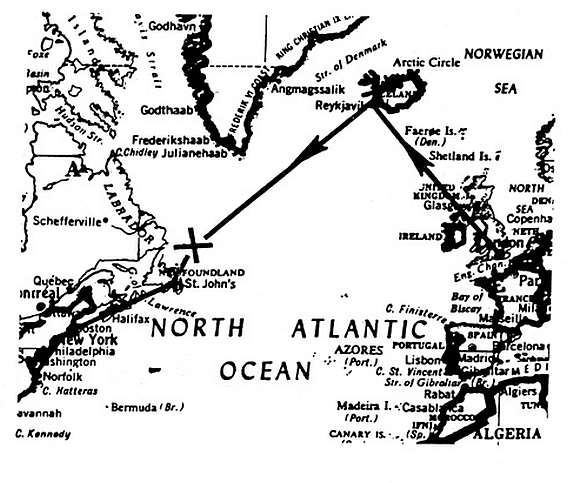
“Since it was time for Lt. J.’s crew to relieve us, I had the plane captain awaken them. When Lt. J. and Lt. M. came up forward, I pointed the lights out to them. Their only comment was that it had to be a ship because it was on the water and we were overtaking it fast. By this time, we were five to seven miles away; it was about 30 degrees to our right; and we had to look down at about a 45-degree angle. The lights had a definite circular pattern and were bright white.
“Suddenly, the lights went out. There appeared a yellow halo on the water. It turned to orange, to a fiery red, and then started moving toward as at a fantastic speed, turning to a bluish red around the perimeter.
Due to its high speed, its direction of travel and its size, it looked as though we were going to be engulfed. I quickly disengaged the autopilot and stood by to push the nose of the plane over in hopes that we could pass under it because of the angle at which it was ascending. The relief crew was standing behind us: everyone began ducking and a few heads were hit on objects.
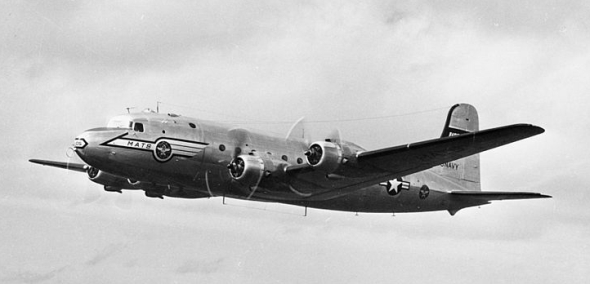
“It stopped its movement toward us and began moving along with us about 45 degrees off the bow to the right, about 100 feet or so below us and about 200 to 300 feet in front of us. It was not in a level position; it was tilted about 25 degrees.
“It stayed in this position for a minute or so. It appeared to be from 200 to 300 feet in diameter, translucent or metallic, shaped like a saucer. A purple-red glow around the perimeter was the same type of glow you get around the commutator of an auto generator when you observe it at night.
“When the object moved away from us, it made no turns, as though it was backing up about 170 degrees from the direction from which it approached us, and was still tilted.
It was only a few seconds before it was out of sight. (Speed estimated in excess of 1,500 mph.)
“All of our cameras were within reach, but no one was calm enough to think about taking a picture. Most of us were wondering what it was. Our impression was that this was a controlled craft. It had been either hovering over the water or sitting on it; then it detected us and came up to investigate.
“After Lt. J.'s crew had taken over, I proceeded aft and learned that most of the passengers had observed the same thing. Since I was unable to identify the object, I asked Dr. M., a commander in the Medical Corps, if he had observed the object. He replied that he had and that he did not look further because it was a flying saucer and he did not believe in such things. I immediately returned to the cockpit and informed the crew to keep quiet about what we observed because it might have been our first sighting of a flying saucer (during those years when you mentioned you had such a sighting, you were believed to be crazy). Lt. J. informed me that it was too late because he had called Gander Airfield in Newfoundland to see if the object could be tracked by radar.
“When we landed we were met by intelligence officers. It was obvious that there had been many sightings in the same area. ... Subsequently, when we arrived in the United States, we had to make a full report and I found out a few months later that Gander radar did track the object in excess of 1,800 mph.”
Source: Lt. George P. Williams, USN, Class IX, Naval Intelligence School
Lt. Williams reports the following personal experience which happened to him about 0300 on the night of 21 February 1951, while he was piloting a Navy Fleet Logistics Air Wing plane:
“We had taken off from Keflavic airport, Iceland, about three hours earlier, and had climbed to cruise at 10,000 feet, heading toward New foundland. It was one of those beautiful nights with a large, almost full moon and a thin layer of broken cumulus below us with tops about 3,000 feet. As we cruised along, I glanced idly about and noticed an unusually bright light through the clouds ahead. At first thinking it was a ship, I called the co-pilot forward. He was in the next compartment talking with other members of the crew.
“We along with others in the 9 man crew watched the light. It rose up from beneath the clouds and approached us at a terrific closing rate. We froze in wonder. It veered to our port side and hovered momentarily as if to examine us. It then rose at an amazingly rapid rate, and disappeared off our port quarter.
“The object was difficult to judge as far as size, but our general estimate was that it was a minium of 200 feet in diameter (and probably larger). It was flat eliptical or cigar-shaped by side view, and seemed to be sqewing (sic) a ring of red-orange exhaust all along the periphery. . “No cockpit-type enclosure was noted. Its speed was so great that we could not comprehend its coming from earth. The one main outstanding feature other than the “fire around the edge” was its large size—larger than an R5D. The question is: Where could such a large object be hangared on earth and be kept a secret?”
Lt. Williams says the sighting occurred at approximately Latitude 60° N, Longitude 33° W. The object was in sight for about five minutes.
Captain Bicknell's Own Story
On a clear morning this week, the pilot, radio officer and passengers of an East African Airways Lodestar saw what they took to be a flying machine of unknown type high over Mount Kilimanjaro. What this machine was, where it had come from and where it was bound, no one knows.
Theories that it was a mirage, a meteorological balloon or the reflection of a normal aircraft have been checked and cross-checked and fallen flat. Highly coloured reports of the incident have been discredited. But the plain facts related by the crew of the Lodestar are themselves enough to baffle the sceptics.
The Lodestar was on the normal Monday morning (2/19) service from Nairobi to Mombasa. It left Nairobi West at 7 a.m. with nine passengers. What happened after that to bast described in the words of the pilot, Captain Jack Bicknell and his radio officer, Mr. D. W. Merrifield, as told to the Sunday Post on Wednesday.
“At 7.20 a.m.,” said Captain Bicknell, "the radio officer drew my attention to a bright object like a white star hanging motionless about 10,000 feet above Kilimanjaro. My first reaction was to say nothing. We watched it for three minutes. Then we told the passengers about it. One of them had a very powerful pair of binoculars with him and he began to study it. In the meantime we put a radio message through to Eastleigh describing it. Eastleigh asked us to check whether it was a 'Met' balloon. I then examined it for several minutes through the binoculars.
“When we first saw it we were about 85 miles from the mountain. Our course took us nearer until we were about 50 miles away from the object.”
“Through the glasses I saw a metallic, bullet-shaped object which must have been over 200 feet long.”
“At one end was a square cut vertical fin. Its colour was a dull silver and at regular intervals along the fuselage were vertical dark bands. Its whole outline was clear and sharp and there was no haziness about it at all.”
“I watched closely for any signs of movement. It was absolutely stationary, and remained that way for 17 minutes.”
“The passengers took turns with the binoculars and two of them were taking photographs. Then it began to move eastwards, rising as it did so. It disappeared at about 40,000 feet.”
“We've calculated that in the three minutes sf visible movement it covered about 60 miles. That gives you a speed of well ever 1,000 m.p.h.”
“Reports that it had windows or portholes are false, and so is the statement that we saw it rising to about 60,000 feet.”
“There were no cloud formations about at all. The machine left no vapour trail, and had no visible means of propulsion.”
Asked if he had any theory about the nature of the machine, the radio officer, Mr. Merrifield said, "If it was a flying machine, it was 500 years ahead of anything we have today."
“My impression," said Captain Bicknell, "was that it was definitely a flying machine of some kind.”
“I would like to believe that it was some kind of mirage,” added Mr. Merrifield, “but I never heard of a mirage without cloud, and that wouldn't explain the movement.”
If this report had come from a few isolated individuals it would soon be discsunted. But it came from two responsible airline officials and nine ordinary travellers. Captein Bicknell took the precaution before landing of asking his passengers to sign a statement verifying his radio report to Eastleigh. It is undoubtedly the best authenticated of all flying saucer stories.
Now let us examine some of the mere plausible theories put forward to explain the phenomenon.
1. The mirage theory is discounted owing to the absence of cloud and the movement of the mystery machine.
2. A meteorological department official said that the giant Skyhook balloon used in America - which are the oause of many “saucer” stories - could not reach East Africa, as they burst after 30 hours in the air. In any case there was not even a remote resemblance to a balloon in the machine seen over Kilimanjaro.
3. The Air France Constellation in the vicinity at the time was moving in a different direction to the 'saucer' as the machine could not have been a distorted reflection of an ordinary aircraft.
So, hopes of a “natural” explanation begin to fade. Other theories range from Martian visitors to radio controlled secret weapons.
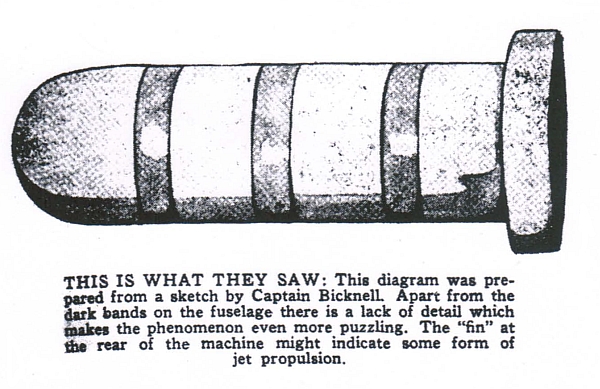
One day we shall know the answer to the flying saucer riddle. Until then any light on the subject would be welcome.
http://www.greenwoodufoarchive.com/uhr/uhr16.pdf
SCITUATE, Mass . Feb 26. AP
--Dr. Anthony O. Mirarchi former Air Force scientist, urged today that radar and spotter observation posts be set up to track down flying saucers “that may lead to another Pearl Harbor.”
Dr. Mirarchi, who investigated more than 300 reports or flying saucers as chief of the Air Force's atmospheric composition bureau of the geographical research division in Watertown last year, brushed aside recent statements by Dr. Urner Liddell (sic), a Navy scientist.
He said Liddell's conclusion that flying saucers really were plastic balloons sent into the upper atmosphere by the Navy for radiation research “does not tell the whole story.”
“The results of my own investigation,” he said. “indicate that we cannot exclude the possibility that the so-called flying saucer is the result of experiments by a potential enemy of the United States.”
“If they were launched by a foreign power, then they could lead to a worse Pearl Harbor than we have ever experienced,” he said.
Dr. Mirarchi urged that a “considerable appropriation be granted the Air Force to set up photographic, radar and spotter tracking points to study the mysterious phenomena.”
He said he had issued a report to the Air Force on his findings last year, but did not know whether the Inquiry had been continued.
He said he was surprised to learn the Navy's opinion of flying saucers and said it was “inaccurate.”
“Some of the reports gathered might well have been of radiation balloons, but that would not account for other observations which seem to exclude them,” he said.
“The Navy's report is erroneous. It lulls people into a false sense of security,“ he added.
Asked about an Air Force statement that more than 500 investigations were made without one bit of concrete evidence to back up reports of flying saucers, Dr. Mirarchi said, “I thought I was the only one making such an investigation. And as far as I'm concerned, there certainly was evidence to back up my conclusion.”
The following information was obtained in a telephone
interview with Robert Wood, former lieutenant commander in the U.S.
Navy and now professor of astronomy and director of the observatory
at Brevard Community College in Cocoa, Florida (407-XXX-XXXX, ext.
417) on March 11, 1980. I had heard about Dr. Wood at a Houston UFO
conference from an acquaintance of his who lives in New Mexico.
— Bob Pratt
(SUMMARY: Wood was the operations officer and air controller aboard the USS Dyess, a radar picket destroyer that was on duty approximately 125 miles SE of Cape May, N.J. The U.S. was involved in the Korean War at the time and it was feared the Russians would bomb Washington. Thus, the destroyer was on the alert for bombers coming in from the northeast, east and southeast.

Click photo for additional images
It was plotting all aircraft going north and south along the coast and in as far as the Appalachian Mountains. About 11:30 one night in March 1951 — he couldn't remember the exact date — he tracked an object coming in from due east at a speed of 85 to 90 knots and an altitude of 3,000 to 4,000 feet. It got within about 30 miles of the destroyer and just stopped and hovered. Wood informed the bridge, which informed the captain, and he instructed them to head out toward the object. About half an hour later, when the ship was within 15 miles of the object, the object suddenly took off on a northerly course very rapidly. Its speed was estimated at about 5,000 kms an hour. The object got to within 35 to 40 miles south of Nantucket Island and suddenly went straight up into the atmosphere. Altitude-determining radar tracked the object up to 100 miles above the earth and still going straight up. A report was made to the Pentagon, but Wood said he never heard anything back.)
The Interview:
Wood: I had one experience in tracking an object on radar. We had a sighting at sea and went toward it to investigate it and got within 15 to 20 miles of the thing and it suddenly took off in a northerly direction at a very high rate of speed, around 5,000 kms per hour or about 3,000 mph, and this was in 1951. So we didn't have any aircraft that could go that fast, especially after it came and hovered. And then when it got up near Nantucket, it just took off and went right straight up.
Pratt: Any idea of the size of the object?
Wood: It gave us a blip about like you'd get on a large aircraft, something like a DC-8 or DC-9, something like that. This was at night. No visual at all, just radar... I was on the USS Dyess, DDR 880, a radar picket destroyer. I was the operations officer and the air controller at that time, so I knew radar and I know what radar will do.
Pratt: The air controller?
Wood: I was Hector Vector, the flight director, air control.
Pratt: Did you report this to the Pentagon?
Wood: We did report it. I heard nothing of it after that.
Pratt: Were you the only ship to pick up on it?
Wood: No, there were several people in the CIC at the time and of course the captain was advised. Otherwise we couldn't have moved the ship out and he came on the bridge...and we headed out toward this object. At the time we were sitting about 125 miles southeast of Cape May, N.J., steaming in a square because this was — in, oh, in March. I don't remember the exact date, March 1951, and we were afraid Russia was going to bomb Washington at that time because we had gone into Korea and all that sort of thing. So we were the first picket destroyer out there and while we were there we were plotting all the aircraft going north and south along the coast and in as far as the Appalachians and any objects that were coming in from the northeast, east, southeast and every aircraft had to be within a certain set of parameters, distances, heights and what not on their point of arrival over us. And on this particular night this object came in from due east and got within about 30 miles from us and stopped dead. It had been moving rather slowly, oh, I'd say in the 85 to 90-knot range, and hovered. And I informed the bridge and they informed the captain and the captain headed the ship out in that direction. We had been loafing along, steaming in circles, so we didn't have all our boiler power on. We did about as much as we could at 22 knots out in that direction, and we got to within, I'd say, about 15 miles from it and it suddenly took off on a due northerly course and we could see as the radar turned we could see the blip just jumping as it moved, it was going so rapidly. We estimated it was going about 5,000 kms or about 3,000 mph. And it got within about 35 or 40 miles south of Nantucket and suddenly just took off, went right straight up. We did have altitude-determining radar aboard the ship and as we started to lose the contact on our normal air search radar — I'd called the bridge and said: "We're losing contact. The object is fading" — the radar operator back in the other end of the radar room said: "No! I've still got it on the altitude-determining radar — it's about 100 miles high and going straight up!"
Pratt: Were you familiar with these things before this?
Wood: No, this was the first time I had ever come across anything like this.
Pratt: What did you think when this happened?
Wood: I wondered what the heck it was. I had no idea what it was.
Pratt: 100 miles up?
Wood: 100 miles altitude, right, going straight up.
Pratt: At what altitude was it hovering?
Wood: We had it coming in at about 85 knots and then it stopped and hovered until we got well out toward it and then it headed north.
Pratt: The altitude?
Wood: The altitude was low, somewhere in the neighborhood of 3,000 or 4,000 feet. We did not have the altitude-determining radar on the line at that moment. In fact, we had to send out and get one of the operators to come up. This was about 11:30 at night.
Pratt: How long was it on the scope?
Wood: The total time was something like 35 to 40 minutes, because we were half an hour under way out toward it before it took off and it had been several minutes from the time we picked it up until; it started to hover...I am a professor of astronomy and director of the observatory here at Brevard Community College.
Pratt: What are your feeling about UFOs?
Wood: Well, there must be something there. There's more smoke than there would be smoldering. There must be fire...
Grips Falls-Fort District
Flying saucers — real or imagined — have border area citizens in whirl today.
Scores of people claim to have seen silvery discs streaking through the stratosphere yesterday afternoon. Bill McClellan of CKFI was one of the many persons who has joined the “I-saw-a-saucer” fraternity.
McCllelan said that the objects he saw resembled a jet plane flying at tremendous height and great speed. Every once in a while the object would stop and remain stationary. “The sun's rays glinted off the thing” and it looked like silver, McClellan is reported as saying.
It would travel fast, then stop, drop, and rise again. The object was joined by another and the two disappeared behind a cloud.
Reports of similar objects came from Duluth radio stations and one from Kansas, but the one that added to the interest — and confusion — was one from New York early this morning.
Don Hollenbeck, ace CBS newscaster and narrator of the News of America program at 8 a.m. daily, reported that flying saucers were observed “over International Falls, Minn., yesterday.” Hollenbeck stated they were travelling about 700 miles an hour.
Letter to Donald Keyhoe - Otto Bock - August 22, 1951
|
Otto Bock |
Dayton August 22 1951. |
|
Dear Mr. Keyhoe! Since I was already during my childhood very much interested in everything which happened to and with the celestial bodys (sic) I naturally read all of your articles about flying saucers I could obtain, particularly your book “The flying saucers are real”. My wife is also very much interested in those facts. Since then we had a strong desire, to see them with our own eyes,(in order to get proof about the flying saucers by our self.) Now, on Friday, Aug. 17. our wishes were unexpectedly fulfilled: By accident I looked up to the sky,( 11.30 AM ) then my eyes were attracted to a very shining spot which remained at the same location in the contrary to the relativly (sic) fast moving clouds and to my judgement the object must have been very high above the clouds and of a tremendous size: it appeared to me approximately with an angle correspondent to a diameter of about ½ that of the sun. In order to check closer on it, I got my telescop (sic) out (20 X ) and then I could see very interesting details, that it was not a cloud but rather a metallic object, shining much brighter then the white clouds, silvery with a slight greenish tint and the sun reflecting on a very particular surface. The attemt (sic) to take a Photograph failed because of the covering clauds; I had to wait always a long time until there was a hole in the clouds to observe it again, but never long or clear enough to take a photograph, which made me very sad. During the period of about 2 hours the object was seen frequently and the observation confirmed by four more persons. That day I was on leaf (sic)) at my home in Dayton. In order to get more information and confirmation I made several phone call with a News-Paper and Wright Field. The News-Paper did not receive any more reports. — With Wright Field I made a somewhat funny experience during my 3 phone calls, but I hesitate to write about it freely in this letter, since I am a member of the group of German scientists at Wright Field. On the other hand we would like it very much to taIk about it with you in case you should have an opportunity to stop hier (sic) in Dayton while on a business trip. Therefore we would appreciate it very much if you would send us a letter in reply to this. Hoping to hear from you I am |
|
/s/ Otto Bock |
|
Otto Bock was a German scientist who came to the U.S. as part of "Operation Paperclip", a program under which military and U.S. intelligence services extracted German scientists from Nazi Germany during and after the final phases of World War II.
Bock's speciality was in the area of optics and high-speed photographic instrumentation which played a major part in advancing U.S. Air Force development of aeroballistic programs.
More information on Otto Bock's career can be found at the official U.S. Air Force site.

|
Auth: GC NEAC Initials: _________ |
||
|
COUNTRY
Canada |
REPORT NO
|
LEAVE BLANK
Date: 10 Oct 51 |
|
AIR INTELLIGENCE INFORMATION REPORT |
|||
|
SUBJECT
Unidentified Aircraft |
(Handwritten) AF 367694 |
AREA REPORTED ON
NEAC |
FROM (Agency)
Dir/Int Hq NEAC |
|
DATE OF REPORT
10 October 1951 |
DATE OF INFORMATION
|
EVALUATION
|
|
|
PREPARED BY (Officer)
Capt. T.V. CANTRELL, Chief, Air Int Div |
SOURCE (Officer) Intelligence Officer, Goose AB, Labrador |
||
|
REFERENCES (Control number, directive, previous report, etc., as applicable)
NEAC TWX INT 9210 to Hq USAF, Director of Intelligence |
|||
Begin text of report on AF Form 112--Part II)
1. On 18, 19 and 20 September 1951 an unidentified aircraft was sighted at approximately 61° 30' N 68° 50' W
2. Aircraft was sighted visually and picked up on the radar set from B-36 No. 44-92668.
3. Unconventional running lights observed.
4. ECM equipment picked up carrier type waves on the following frequencies: 367, 849, 822, 991, 730, 715 and 730 mcs.
APPROVED:
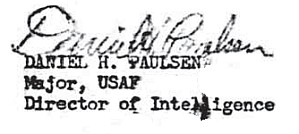 |
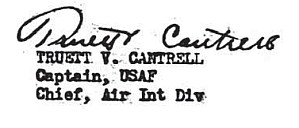

 The 30th Air Division, active from 1949 until 1968, was originally
based at Selfridge Air Force Base, Michigan. Assigned to the Air Defense Command
(ADC) for most of its existence, the 30th's initial mission
was the equipping, administering, training, and provisioning of
operationally ready forces to the appropriate commanders for the air defense
of upper Great Lakes area of the United States. Their Area of Operation
included maintaining air defenses above the closely guarded AEC nuclear facilities at the
Oak Ridge plant, Tennessee.
The 30th Air Division, active from 1949 until 1968, was originally
based at Selfridge Air Force Base, Michigan. Assigned to the Air Defense Command
(ADC) for most of its existence, the 30th's initial mission
was the equipping, administering, training, and provisioning of
operationally ready forces to the appropriate commanders for the air defense
of upper Great Lakes area of the United States. Their Area of Operation
included maintaining air defenses above the closely guarded AEC nuclear facilities at the
Oak Ridge plant, Tennessee.